مع التحولات الرشيقة في ازدياد تستمر شعبية التخطيط السريع في الازدياد - وغالبًا ما تكون النتائج مقنعة. تكتسب الشركات المرونة، وتحل المشاكل الكبيرة، وتحظى بفترات توقف مدمجة بين عمليات التطوير حيث يمكنها تقييم التقدم المحرز وإعادة التقويم حسب الضرورة.
إذا كنت جديدًا على التخطيط السريع، فإليك كل ما تحتاج إلى معرفته. وإذا لم تكن جديدًا وتحتاج فقط إلى بعض برنامج إدارة المشاريع لتبدأ؟ لقد قمنا بتغطيتك - مجاناً - بميزات برنامج ClickUp السريع والمرن.
ما هو التخطيط السريع؟
تخطيط السبرنت هو عملية تحديد ما الذي تريد تحقيقه في سباق سريع (أهدافك) و كيف_ ستحققه (الخطة) في سباقك السريع التالي بناءً على أهداف العمل, تراكم المنتج الخاص بك وقدرة الفريق وسرعته. يجب أن يكون اجتماع التخطيط لسباق السرعة الخاص بك يحدد التوقعات، ويمنح الفرق التوجيهات، و يضمن أن الجميع على نفس الصفحة قبل كل سباق.
انتظر لحظة... ما هو العدو السريع؟ إذا كنت جديدًا في مجال العمل الرشيق، فإليك هذا التوضيح السريع: العدو السريع هو إطار زمني قصير (عادةً ما يكون أسبوعين فقط، على الرغم من وجود سباقات سريعة مدتها أسبوع واحد وأربعة أسابيع) يخطط فريقك خلالها لتقديم شيء ما.
والفكرة من وراء تنظيم سباقات السرعة هي بدلاً من التخطيط لعام كامل لفريق التطوير الخاص بك وعدم ترك أي مجال للإبداع أو الابتكار أو تحولات السوق أو حالات الطوارئ، فأنت تخطط لتسليم العناصر ذات الأولوية في جدول زمني قصير. وهذا يترك مجالاً للنمو وتغيير الأولويات. كما أنه يعني أيضًا أن الفرق تقدم باستمرار ميزات أو منتجات ذات أولوية، ومع تغير الأولويات، يتغير أيضًا ما تعمل عليه فرقك.
فوائد التخطيط السريع
إذن، لماذا تقوم العديد من الشركات بالتخطيط السريع هذه الأيام؟ ما الذي تفعله هذه الممارسة بالضبط لفرقك وعملائك وأرباح شركتك؟ الإجابات جذابة للغاية:
عمليات عمل أكثر مرونة
إن الفكرة الأساسية وراء ممارسة العدو السريع هي: فترات العمل القصيرة والمحددة جيدًا تعني تسليم أسرع ومرونة أكبر. فهي تتيح للفرق تحويل المشاريع الكبيرة إلى مشاريع أصغر حجماً وأكثر مراحل يمكن التحكم فيها وإعطاء القيادة نقاط تحقق محددة مسبقًا حيث يمكنك توجيه المشاريع أو إعادة تحديد أولوياتها أو حتى إلغاء المشاريع بناءً على معلومات جديدة مثل تحولات أهداف العمل أو التغييرات الرئيسية في السوق.
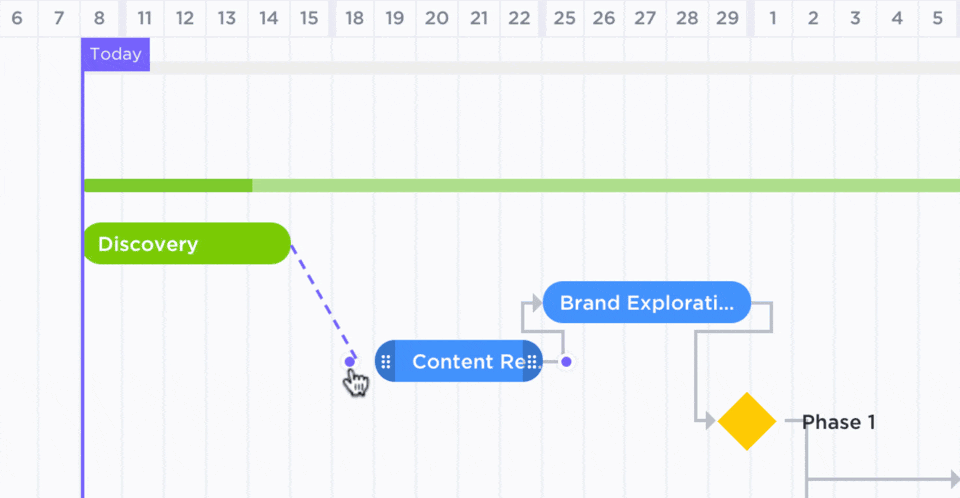
إظهار العلاقات بين المهام والمهام المتطلبة في طريقة عرض جانت في ClickUp
تعاون أفضل
كلما كانت خطتك أكثر وضوحًا (وأكثر مرونة)، كان من الأسهل على الفرق التعاون بفعالية لإنجاز المهام. كما أن الإيقاف المؤقت المدمج عند الانتهاء من أحد السباقات والبدء في السباق التالي يمنح الفرق نقاط تسجيل دخول تلقائية.
نصيحة إنتاجية ملاحظة ... قال 25% من عملاء ClickUp أنهم انتقلوا إلى منصتنا لأنهم كانوا بحاجة إلى أدوات تعاون أفضل، وقال 91% منهم أن التعاون قد تحسن بعد إجراء التبديل .
لا مزيد من التخمين
من خلال توفير توجيه واضح بشأن الأهداف، والمعالم، ومسؤوليات الفريق، والقيمة المتوقعة، فإن التخطيط السريع يزيل التخمين من عملياتنا. وهذا يعني قضاء وقت أقل في طرح الأسئلة المتعلقة بالصورة الكبيرة في منتصف المشروع (تقليل التأخيرات) ومساحة أقل للتخمينات غير الصحيحة حول ما تريده القيادة (تقليل العمل المكرر).
موظفون أكثر سعادة
لا أحد يريد أن يقضي وقته في العمل وهو غير متأكد مما يحتاج إلى تسليمه، أو في أي وقت، أو كيف سيتم تحديد نجاحه. إنه أمر مرهق ويأخذ الطاقة الإبداعية بعيدًا عن حل مشاكل العمل الفعلية.
مع وجود قائمة واضحة يمكن التحكم فيها مخرجات المشروع وجدول زمني محدد ومعقول (أسابيع بدلاً من أشهر)، لا يتعين على الفرق أن تخمن أولوياتها أو النتائج المتوقعة أو ما يجب أن تعمل عليه. هذا يقلل من التوتر والنفقات الذهنية (كمية المعلومات التي يحملها الأشخاص في أذهانهم للقيام بعملهم)، مما يساهم أيضًا في الإنتاجية.
استراتيجيات يمكنك التعلم منها
كلما وثقنا خططنا بشكل أفضل، كلما تعلمنا منها بشكل أفضل. ما الذي نجح بشكل جيد؟ ما الذي لم ينجح على الإطلاق؟ ما العقبات التي واجهتنا والتي يمكننا تجنبها في المستقبل؟
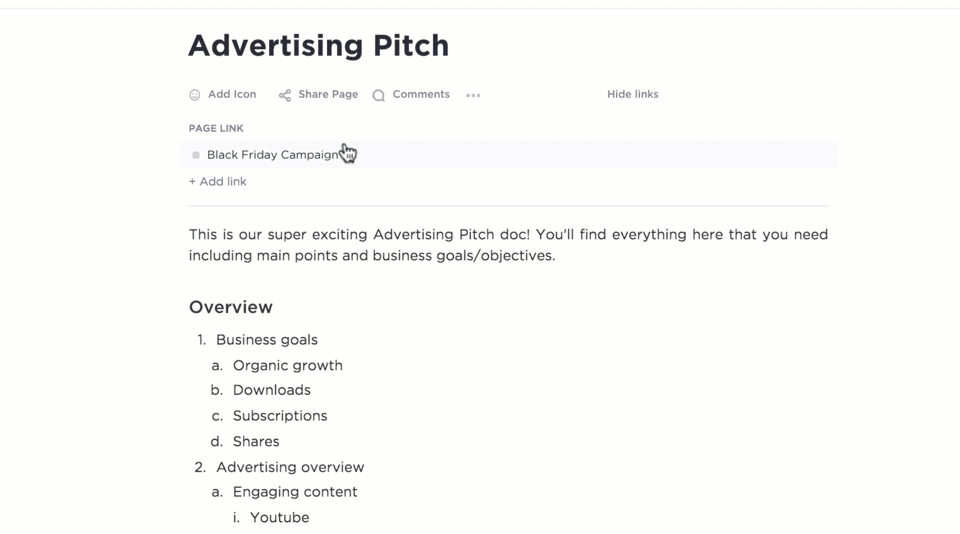
باستخدام علاقات النقر فوق، من السهل ربط المهام والمستندات من مساحة العمل
تعني سباقات السرعة القصيرة أننا نطرح هذه الأسئلة كثيرًا (ونتعلم منها كثيرًا أيضًا). تعني الخطط المحددة جيدًا وسباقات السرعة الموثقة جيدًا إجابات أوضح عندما نطرح هذه الأسئلة. والتكرار الاستراتيجي يعني التحسين المستمر (وتقليل التعلق بالعادات القديمة).
متى يجب أن يحدث التخطيط للسباقات السريعة؟
يجب أن يحدث التخطيط للسباق السريع قبل سباقك السريع و بعد تنقيح الأعمال المتراكمة, مراجعة العدو السريع و سبرينت بأثر رجعي من سباقك السريع السابق (حيث ستتعرف على الممارسات التي يجب على الفرق تكرارها أو التخلص منها من السباق السابق).

ما هي مدة جلسة التخطيط للسباق السريع؟
عادةً ما تستغرق اجتماعات التخطيط للسباق السريع حوالي ساعة واحدة لكل أسبوع من السباق السريع. (على سبيل المثال: إذا كنت تقوم بجلسات تخطيط للسباقات السريعة لمدة أسبوعين، فإن اجتماعك يجب أن يكون حوالي ساعتين. إذا كنت تقوم بالسباقات السريعة لمدة ثلاثة أسابيع، فخطط لوقت مدته ثلاث ساعات)
ومع ذلك، هناك طرق لإبقاء التخطيط لسباقات السرعة أقصر وأجمل. تحتاج الشركات إلى إبقاء الأعمال المتراكمة لديها منقحة ومطالبة القيادة بالحضور إلى الاجتماع بخطة واضحة المعالم.
وهذا يسمح للقيادة بتحديد الأولويات، وتقليل مدة الاجتماعات إلى 30 دقيقة، حتى يتمكنوا من التركيز فقط على ميزة الإبلاغ عن الميزات أي شيء لن يتم إكماله/لم يتم إكماله في السباق الحالي. بعد ذلك، يمكن للفريق مراجعة الأولويات المقترحة من الأعمال المتراكمة (النظيفة والمنقحة) والحصول على إجماع الفريق.
كما هو الحال مع أي اجتماع، كلما كان الاجتماع أقصر كان ذلك أفضل. تشير الأبحاث إلى أن متوسط فترة الانتباه يتراوح بين 10 و18 دقيقة فقط ( وهذا هو السبب في أن مدة محادثات TED هي 18 دقيقة أو أقل ). على الرغم من أننا نشك في أنك ستقلل من جلسات التخطيط الخاصة بك إلى هذا الحد، ابحث عن طرق لتقليل الدهون.
نصائح لجعل الاجتماعات أقصر إن وضع مؤقت، وجعل الناس يدونون الملاحظات باليد (وليس على أجهزة الكمبيوتر المحمولة)، والتحقق من الهواتف المحمولة عند الباب، والتخطيط للصمت في اجتماعاتك (نعم، حقاً!) هي مجرد عدد قليل من الأشياء التي تقوم بها الفرق الناجحة لمنع الاجتماعات من أن تطول، وفقاً ل FastCompany .
إذا كنت تخطط لفعل شيء غير تقليدي مثل حظر الهواتف المحمولة أو إزالة الكراسي، فتأكد من أن لديك خطة لإمكانية الوصول لموظفيك ذوي الاحتياجات الخاصة. بعض الأشخاص لا بد من الجلوس والبعض الآخر قد يحتاجون إلى هواتفهم للتنبيهات الطبية.
من يشارك في التخطيط للسباق؟
في حين يجب أن يكون فريق التطوير بأكمله جزءًا من اجتماع التخطيط الخاص بك، فإن المخططين الأساسيين هنا هم مدير Scrum الرئيسي ومالك المنتج والمدير الهندسي.
يقود مدير Scrum الرئيسي فريق سكرم ويتأكد من حصولهم على ما يحتاجون إليه في السباق الجديد (إعدادهم للنجاح). مالك المنتج هو المسؤول عن رؤية المنتج وتراكمات المنتج.
يجب أن يكون على اتصال وثيق مع العميل ويكون مسؤولاً عن تطوير وتحديث الأعمال المتراكمة للمنتج. يجب أن يشارك المدير الهندسي في أي تحديد للنطاق أو المواءمة قبل الاجتماع.
أيضًا - ولا سيما - الطباعة ليست فقط لفرق التطوير الخاصة بك. تقترح ماكينزي تنفيذ التحولات الرشيقة في سباقات السرعة . وتقول هارفارد بزنس ريفيو سباقات السرعة هي لحل المشاكل الكبيرة . لقد ثبتت فائدة التفكير والتخطيط على دفعات قصيرة - لأكثر من نوع واحد من الفرق - مرارًا وتكرارًا من قبل قادة الصناعة وكبرى مؤسسات أبحاث الأعمال.
ما الذي يتضمنه التخطيط السريع؟ انقر فوق الأهداف : بمجرد أن يحدد مالك المنتج أهدافك، فإن اجتماع التخطيط للسباق السريع هو الوقت المناسب للتأكد من أن الفريق على دراية بما يحدث. كلما فهموا ما يهدفون إليه بشكل أفضل، كلما كان كل سباق سريع أكثر نجاحًا.

أنشئ أهدافًا شخصية داخل ClickUp وحدد أهدافًا لتتبع تقدمك
اختيار الأعمال المتراكمة: يفضل أن يكون مالك المنتج قد حدد أولويات الأعمال المتراكمة قبل اجتماع تخطيط السباق السريع، وخلال الاجتماع، سيقوم توصيل هذه الأولويات إلى الفرق .
تواجه صعوبة في الحفاظ على تنظيم أعمالك المتراكمة؟ جرب قوائم ClickUp ! لا يمكنك فقط جمع عناصر القائمة المتراكمة في مكان واحد وترتيب المهام المرفقة بها فحسب، بل يمكنك أيضًا تجميع كل عنصر من عناصر القائمة داخل مجلدات مشروع محددة، وإضافة المعلومات ذات الصلة بكل عنصر من عناصر القائمة (المالكين، والمرفقات، وما إلى ذلك)، وفرز المهام حسب الحالة، وسحب المهام وإفلاتها بسهولة لتغيير الحالة. تحديثات سهلة وفورية تجعل من هذه القوائم ميزة كبيرة خلال اجتماع التخطيط.
السرعة: ما مدى سرعة فرقك؟ كلما كان بإمكانك الإجابة على هذا السؤال بشكل أفضل (على أساس كل فريق على حدة)، كلما كان بإمكانك التخطيط بشكل أفضل. استخدم سباقات السرعة السابقة لحساب سرعة الفريق لسباقات السرعة المستقبلية وخلال اجتماع التخطيط، تحقق من ذلك. هل تعتقد الفرق أن هذا المشروع قد يتطلب جدولاً زمنياً أطول أو أقصر؟ استفد من الاجتماع للحصول على مدخلاتهم وتجنب التقليل أو المبالغة في الجدولة. السعة : بالحديث عن نقص أو زيادة في الجدولة, السعة هي المقياس الآخر الذي يجب أن تخطط له. لتحديد ذلك، تحتاج إلى معرفة ما لدى الفريق (أو كل عضو من أعضاء الفريق) من مهام بالفعل، وما يمكن وما لا يمكن دفعه، وكيف تتقاطع أولوياتك مع أولوياتهم الحالية. (ملاحظة.. عرض عبء العمل في ClickUp يمكن أن يساعد في ذلك)
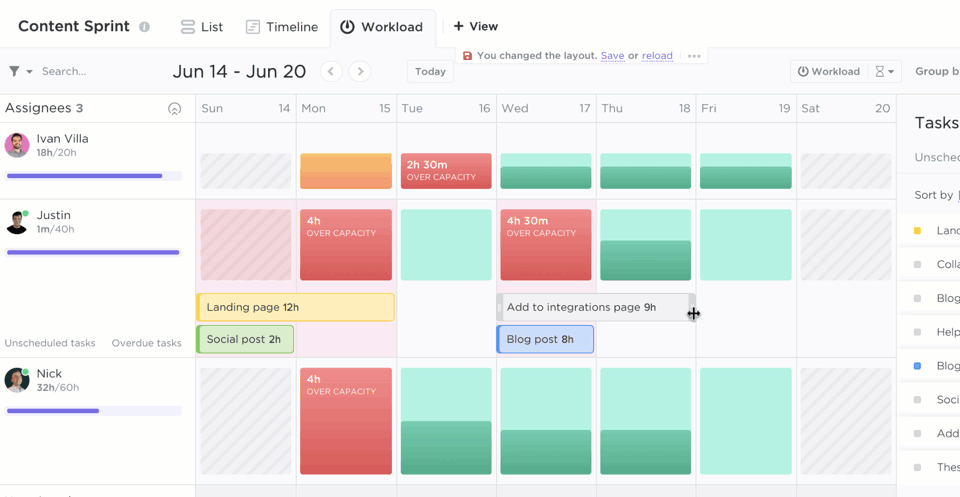
استخدم طريقة عرض عبء العمل في ClickUp لمعرفة من هو متقدم أو متأخر وسحب المهام وإفلاتها بسهولة لإعادة تخصيص الموارد
عند تحديد السعة، تستخدم العديد من الفرق نظامًا مثل النقاط السريعة ، والذي يسمح لك بتعيين عدة نقاط يمكن للفرق معالجتها في فترة محددة ثم تعيين قيمة نقطة لكل مهمة لمعرفة كيف تتناسب مع السعة الإجمالية الكلية.
تجدر الإشارة إلى أن تخطيط القدرات لا يجب أن يتعلق الأمر فقط بتحديد تواريخ الاستحقاق. بل يتعلق بمواءمة الفرق حول النطاق و الجهد المطلوب لإنجاز شيء ما. يساعد نظام النقاط في تحديد أي اختلافات كبيرة في الفهم.
إذا قال أحد المهندسين إن الجهد المطلوب هو نقطتان وقال آخر إنه سبع نقاط، فأنت تعلم أن هناك شخصًا ما ينقصه شيء ما. يمكن أن يساعدك هذا على إبراز التبعيات وتوضيح الافتراضات قبل بدء السباق السريع.
التبعيات: يجب أن تكون التبعيات المشتركة بين الفرق جزءًا من تخطيط ما قبل البصمة ويجب أن تظهر خلال الاجتماع للتأكد من أنك قمت بتخطيطها جميعًا (آخر شيء تريده هو اكتشاف تبعية ضخمة في اللحظة الأخيرة تخرج الخطة عن مسارها).

كيفية إضافة تبعية إلى علاقة في ClickUp
المهام: كيف سنصل إلى الهدف الذي حددناه؟ ما هي المهام والمعالم الرئيسية وترتيب العمليات التي سنحتاج إلى إكمالها؟ من هو المكلف بأي مهمة وكيف سينجزها؟ يجب أن يكون لدى مدير مشروعك بالفعل الجدول الزمني لإدارة المشروع مع إجابات على هذه الأسئلة. استخدم وقت اجتماعك للتعديل حسب الحاجة إذا قدم فريقك معلومات جديدة أو تقديرات زمنية جديدة وما إلى ذلك. المقاييس : أخيرًا، تأكد من أن اجتماعك يجيب على سؤال رئيسي: كيف ستعرف ما إذا كنت ناجحًا؟ ما هي المقاييس التي ستحكم من خلالها على فعالية السباق السريع؟ ما الذي يجب أن تهدف إليه الفرق والأفراد بالضبط؟

توفر طريقة عرض عبء العمل ClickUp Workload View رؤى حول مقاييس مشروعك لتكون متقدمًا بخطوة إلى الأمام
أفضل ممارسات التخطيط السريع
إذن، أنت تعرف ما هو اجتماع التخطيط السريع، ومتى تعقده، ومن المسؤول عنه، وما الذي يغطيه. والآن، اجعله أفضل مع بعض النصائح من الخبراء:
1. اجعله قصيرًا ولطيفًا
لا أحد يحب الاجتماعات الطويلة. حتى الاجتماعات المهمة. وهذا يعني أنه إذا كنت تريد أن يكون اجتماعك قصيرًا إلى أقصى حد وأن يواجه مقاومة أقل، فيجب على مديري المشاريع والقيادة أن يبذلوا جهدًا مسبقًا لجعل الاجتماع الفعلي قصيرًا وبسيطًا قدر الإمكان.
2. ادخل بجدول أعمال واضح
بالحديث عن إبقاء الأمور قصيرة وواضحة، فكلما كان جدول أعمالك واضحًا، كلما كان اجتماعك أسرع (وأفضل). اعرف ما تحتاج إلى التحدث عنه وبأي ترتيب وبأي أولوية. وابدأ بالأشياء التي تتطلب التركيز الأكبر.
3. ابدأ بالسبب
كما يقول سايمون سينيك (من مشاهير TED Talk) : "الناس لا يشترون ما تفعله، بل يشترون لماذا تفعله." وهو يتحدث في المقام الأول عن العملاء، ولكن الأمر نفسه ينطبق على الفرق الداخلية. إذا كنت تريدهم أن يشتركوا في مشروع ما ويضعوا كل ما لديهم فيه، فعليهم أن يعرفوا سبب أهميته. ما هي الأهداف التي يعملون على تحقيقها وكيف تؤثر هذه الأهداف على حياة العملاء أو الموظفين للأفضل؟
4. أزل العبء عن فريقك
يجب على مديري المشاريع وقادة الفرق أن يجعلوا الأمر سهلاً قدر الإمكان على الفريق للموافقة على الخطة. لا تستخدم اجتماعك كـ جلسة عصف ذهني أو إثقال كاهل الفرق باكتشاف خارطة الطريق بمفردهم. تعال باقتراحات واضحة ودع الفريق يقدم ملاحظات مفيدة بدلاً من ذلك. هذا هو الاستخدام الأكثر كفاءة للوقت ولا يسرق التركيز أو الطاقة الإبداعية من فرقك.
5. تحديد النجاح
كيف تبدو جلسة التخطيط الناجحة؟ ما الذي تريد أن تخرج الفرق بمعرفته؟ ما هي الأسئلة التوضيحية التي تحتاج إلى الحصول على إجابات لها؟ هل يطلق الفريق في نهاية هذا السباق وكيف يؤثر ذلك على تخطيطك؟ يجب أن تدخل إلى الاجتماع وأنت تعرف بالفعل ليس فقط كيف سيبدو سباق السرعة الناجح، ولكن أيضًا كيف يجب أن يبدو اجتماع التخطيط الناجح في النهاية.
6. وضع أهداف واقعية واقعية
مع وصول الإنهاك ومعدل الدوران إلى معدلات تنذر بالخطر، أصبح من المهم أكثر من أي وقت مضى أن تكون واقعيًا بشأن ما يمكن للفرق والأفراد تحقيقه. استخدم السرعة السابقة لوضع خطتك، ولكن استمع أيضًا عندما تخبرك الفرق أنها ستحتاج إلى مزيد من الوقت أو أنها تكافح من أجل الوصول إلى أهدافك.
بالنسبة للعديد من الفرق، فإن وضع هدف واقعي وقابل للتحقيق و هدف ممتد مع الحوافز الإضافية يمكن أن يساعد في ضمان أن الفرق لا تحرق الشمعة من طرفيها بل تسعى إلى تحقيق أشياء كبيرة.
7. إجراء عمليات إعادة النظر
يجب أن تسترشد كل سباق سريع بالسباقات التي تأتي بعده. ما الذي قامت به الفرق بشكل جيد (ويمكن تكراره)؟ ما الذي يحتاج إلى بعض العمل؟ ما الذي تعلمته من سباقات السرعة السابقة؟ كيف يمكنك تطبيقها في المستقبل؟ يمكن أن تساعدك عمليات إعادة النظر المنتظمة في الحصول على الإجابات وإدراجها في جلسة التخطيط التالية.
_جرب هذه
_مراجع/ https://clickup.com/blog/retrospective-tools// أدواتأثر رجعي_ %/%href/_
!
نصيحة احترافية هل تريد المزيد من النصائح؟ اطلع على هذه المجموعة من نصائح لإدارة المشاريع الرشيقة من أكثر من 20 خبيراً
أدوات التخطيط السريع التخطيط للسباق السريع هو عمل استراتيجي كبير - وامتلاك الأدوات المناسبة أمر بالغ الأهمية. (نحن نعلم أننا متحيزون، ولكن مع قول 96% من عملائنا أنهم أصبحوا أكثر كفاءة بعد اعتماد أدواتنا، نعتقد أن هيئة المحلفين متفقة تمامًا).
إليك ثلاثة من ClickUp قوالب رشيقة التي قد تكون مفيدة ل التخطيط للسباق السريع اجتماع
1. نموذج ClickUp Agile لإدارة المشاريع الرشيقة
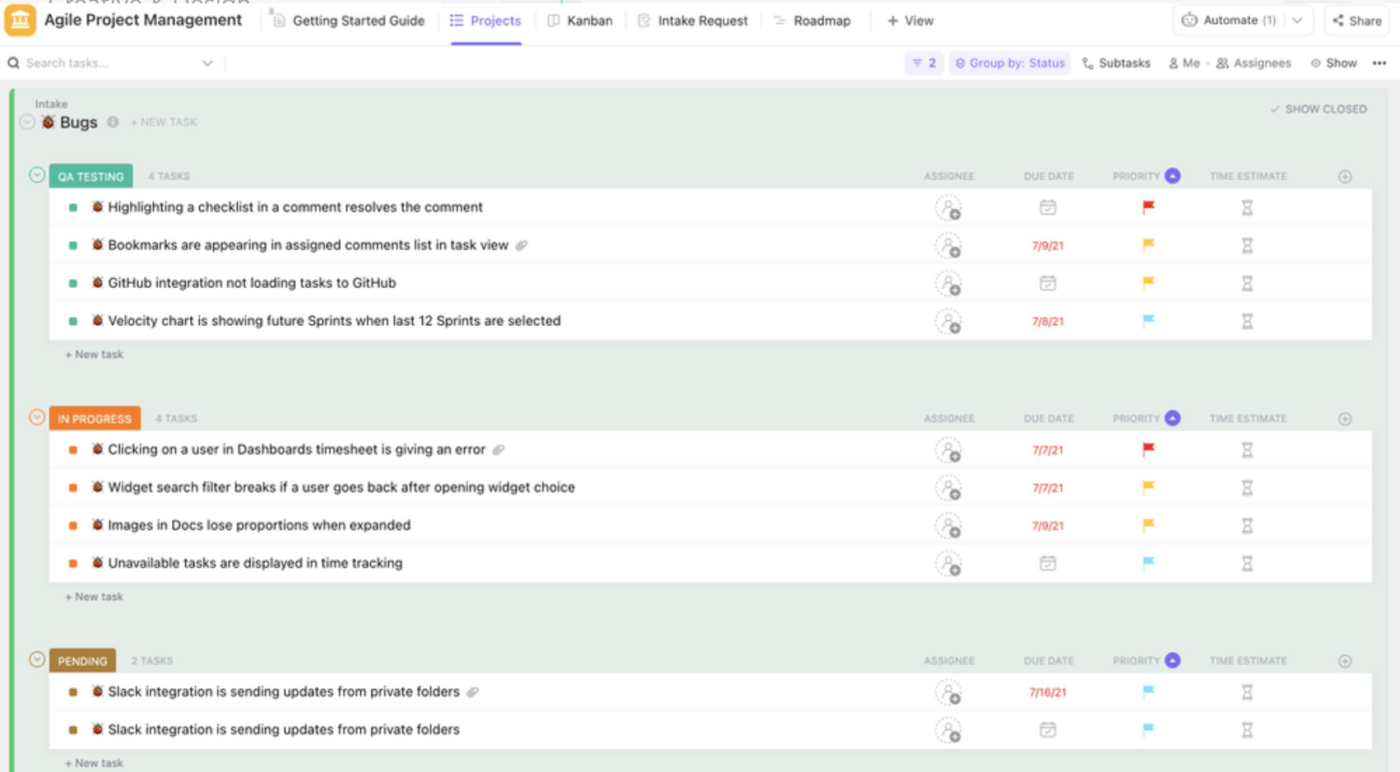
استخدم هذا القالب الرشيق لتتبع مراحل الاختبار والتنفيذ لأهم مشاريعك
قالب نموذج ClickUp Agile لإدارة المشاريع الرشيقة يتيح لك عرض التقدم المحرز في لمحة سريعة وتتبع سباقات السرعة وتخصيص الحالات لتلبية الاحتياجات الفريدة لفرقك.
تنزيل هذا القالب
2. قالب ClickUp Agile Scrum Management قالب إدارة Agile Scrum
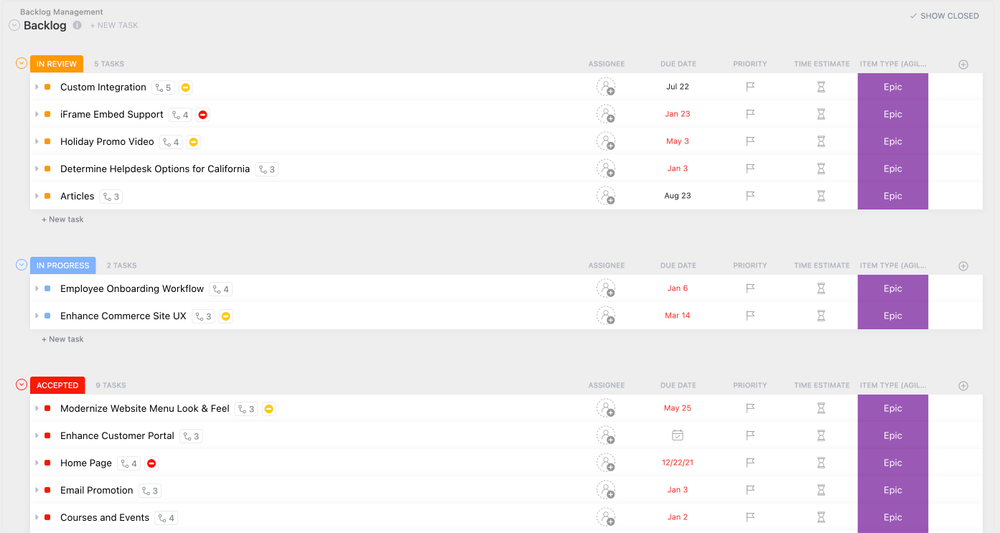
قم بإنشاء أعمال متراكمة مفصلة باستخدام قالب Agile Scrum البسيط هذا وابدأ على الفور
من الأعمال المتراكمة إلى سباقات السرعة إلى الاستعراضات بأثر رجعي، هذا انقر فوق قالب إدارة سكرم الرشيقة يضع جميع عناصر التخطيط للسباق السريع التي تحتاجها في مكان واحد سهل العرض والتعديل.
قم بتنزيل هذا القالب
3. قالب العصف الذهني للعصف الذهني لسباق السرعة
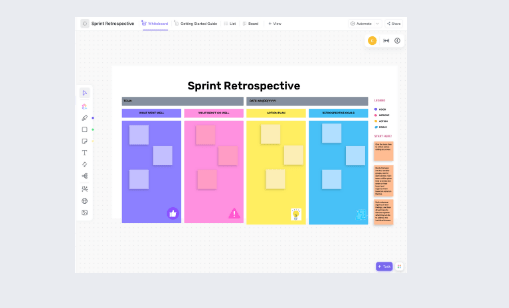
استخدم قالب السبورة البيضاء هذا للتخطيط بشكل أكثر وضوحًا لتخطيط عملية الاسترجاع التالية
هل تقوم بإجراء استعراض بأثر رجعي بعد سباق واحد وقبل السباق التالي؟ إن قالب العصف الذهني للعصف الذهني بأثر رجعي لسباق السرعة يحتوي على كل ما تحتاج إليه.
مكافأة:_
_/مرجع/ https://clickup.com/blog/sprint-retrospective-templates// طباعة القوالب بأثر رجعي* %/%href/_
تنزيل هذا القالب
هل أنت مستعد للبدء؟ سبرينت كليك أب المجاني و
رشيق صُممت الأدوات لمساعدة مالكي المنتجات وقادة Scrum على التخطيط المسبق، وإدارة اجتماعات تخطيط سباقات السرعة وتتبع المشهد المتغير باستمرار لكل مشروع. وبمساعدة ClickUp، يمكن لفريقك القيام بذلك. جربه مجانًا لترى لماذا تنتقل العديد من فرق التطوير إلى ClickUp لإدارة تخطيط سباقات السرعة والمراجعات.

